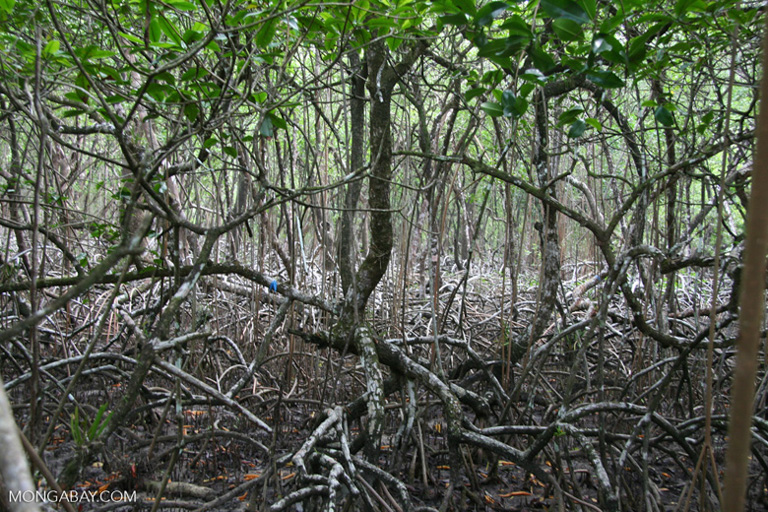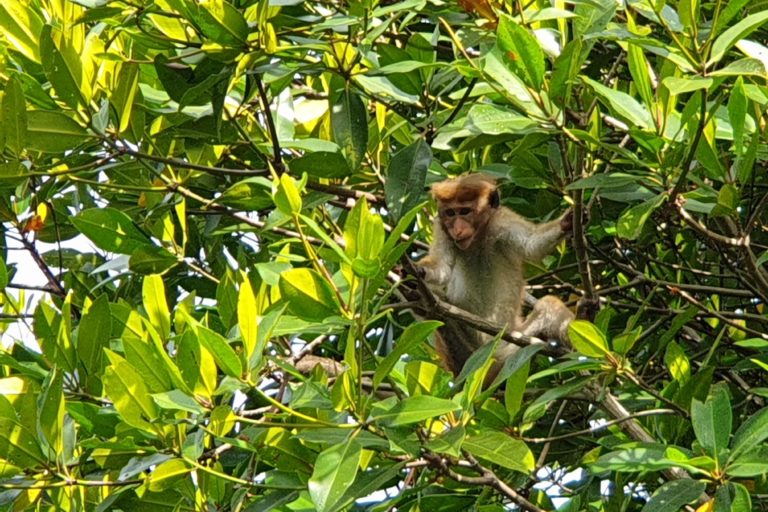- If carbon dioxide emissions are not reduced, mangroves will be unable to keep up with the resulting rise in sea levels and they could start drowning by 2050, according to new study in the journal Science.
- Researchers base their findings on the fate of mangroves from 10,000 years ago, when glacial melting made sea levels rise.
The threshold beyond which the world’s mangrove forests can survive could be reached within the next 30 years if sea levels continue to rise at their current pace and greenhouse gas emissions are not curbed, according to new research.
Mangroves have two particularly important roles: they buffer vulnerable coastlines from severe weather systems such as cyclones and storm surges, and are considered to be some of the most valuable carbon sinks of any terrestrial forests.
Researchers studied samples of sediment from 78 tropical or subtropical mangroves that built up between 10,000 and 7,000 years ago, part of what are known as the final stages of the Holocene period, when glaciers were melting and sea levels rose as a result.

They determined that mangroves can only withstand a maximum relative rise in sea levels of 7 millimeters, about a quarter of an inch, per year: “a limit beyond which mangrove systems cease to function,” according to a statement that accompanied the report.
Mangroves are able to adapt to fluctuations in sea level, but they have their limits, said one of the report’s co-authors, Neil Saintilan, a professor in the Department of Earth and Environmental Sciences at Macquarie University in Sydney, Australia.
If the process of accretion, in which soil deposits build up around mangrove roots in response to rising sea levels, cannot keep up with these changes, then “mangroves cannot stay in place (they drown),” Saintilan wrote in an email.

He said mangroves have what is known as elevation capital, which is the point beyond which they drown. “[H]owever, once the 7mm per year sea-level rise threshold is reached, it is only a matter of time before the world’s existing mangrove forests collapse — it is from that point inevitable,” he wrote. “Sea-level rise has huge lag times, so even if emissions from that point come under control, the high rates of sea-level rise will continue for a very long time after (centuries).”
Saintilan said the study had found instances where mangrove peat was more than 10 meters (33 feet) thick, “so we know mangroves can easily cope with 10 metres of sea level rise.”
But what is critical is the rate at which the levels rise over longer, sustained periods of time. “[T]heir response is very sensitive to the rate of rise over the timescale of decades to centuries. That’s where the 5mm per year and 7mm per year thresholds come in. If we control warming under the low emission scenarios, we are suggesting that there is no reason to think the rate of sea-level rise will reach a point that poses a threat to mangroves, so that’s the good news story,” Saintilan said in his email.
In February, research found that the last time carbon dioxide levels in the atmosphere were as high as they are today, sea levels rose by 15-25 meters (49-82 feet).

According to a study released in 2018, undisturbed mangrove forest soil was found to have stored up to 6.4 billion tons of carbon in 2000, but at least 122 million tons of this was lost over the next 15 years. In addition to sea level changes, mangroves are particularly at risk from erosion and deforestation.
Asked if the drowning of these forests could affect existing carbon stocks, Saintilan said that if more exposed mangroves die off, the carbon-rich soil could be affected by wave attack, but that research continues in this area.
But it’s not only mangroves’ abilities to grow vertically that are under threat. While he was not involved in the study, John Howes, a Malaysia-based wetland ecologist and associate expert with Wetlands International, has studied how mangroves respond and adapt to tidal changes, wave surges, changes in currents and sea levels. In addition to growing vertically, mangroves will also grow or retreat back toward the land. “[B]y in-land migration,” he wrote in an email, “mangrove systems colonize lands” behind their existing boundaries.
He said that across Southeast Asia, these “elastic ecosystems” are under increasing pressure as coastal developments and man-made dikes, bunds or embankments are built around their edges.
“This bund will prevent any opportunity for in-land migration of mangrove systems in response to sea level rises, and mangrove systems will … be squeezed between the sea and the bund. As such, I imagine that initially the mangrove zonations within a system will become narrower, and the most diverse back-mangal communities will be likely reduced most.”
Banner image: Mangrove forest at MSN island in Myanmar, a nursing ground for various mangrove species. Photo by Ann Wang for Mongabay.
Citation:
Saintilan, N., Khan, N. S., Ashe, E., Kelleway, J. J., Rogers, K., Woodroffe, C. D., & Horton, B. P. (2020). Thresholds of mangrove survival under rapid sea level rise. Science, 368(6495), 1118-1121. doi:10.1126/science.aba2656

